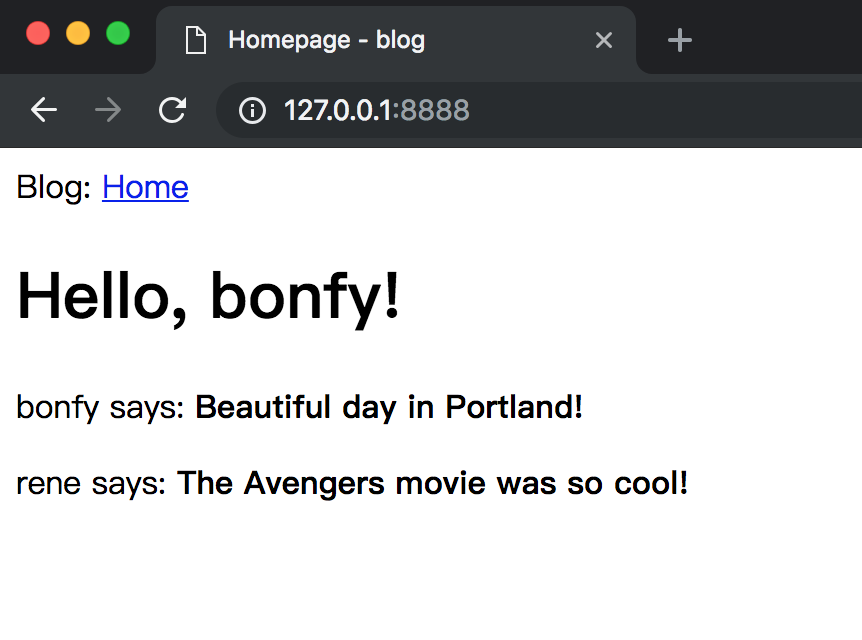- 03-Template Advance
- 匿名组合
- 模板继承
- Links
03-Template Advance
学习完 第二章 之后,你对模板已经有了基本的认识
本章将讨论 Go 的组合特性,以及 建立一个通用的调用 模板的方法
本章的GitHub链接为: Source, Diff,
Zip
匿名组合
匿名组合 其实是Go里的一个非常重要的特性,在 Go 的世界里没有继承,只有组合(当然还有接口)。组合其实可以实现部分的继承。
main.go
type Post struct {UserBody string}// IndexViewModel structtype IndexViewModel struct {Title stringUserPosts []Post}
就是 将 User User -> User其它都不变,这样执行,发现程序照常运行
不过,现在我们可以改下templates/index.html
templates.index.html
<html><head>{{if .Title}}<title>{{.Title}} - blog</title>{{else}}<title>Welcome to blog!</title>{{end}}</head><body><h1>Hello, {{.Username}}!</h1>{{range .Posts}}<div><p>{{ .Username }} says: <b>{{ .Body }}</b></p></div>{{end}}</body></html>
由于 匿名组合 ,我们现在可以将 {{.User.Username}} -> {{.Username}}
就是我们可以直接使用 匿名组合 的属性,以及方法,其实也是变像的实现了继承。
关于 Go 的 面向对象,可以看下 参考
本小节 Diff
模板继承
其实 Go 的模板应该没有 Flask jinja2 这样的功能强大,它只有 include,所以为了实现模板的继承,我们需要发挥下主观能动性
index.html
package mainimport ("html/template""io/ioutil""net/http""os")// User structtype User struct {Username string}// Post structtype Post struct {UserBody string}// IndexViewModel structtype IndexViewModel struct {Title stringUserPosts []Post}// PopulateTemplates func// Create map template name to template.Templatefunc PopulateTemplates() map[string]*template.Template {const basePath = "templates"result := make(map[string]*template.Template)layout := template.Must(template.ParseFiles(basePath + "/_base.html"))dir, err := os.Open(basePath + "/content")if err != nil {panic("Failed to open template blocks directory: " + err.Error())}fis, err := dir.Readdir(-1)if err != nil {panic("Failed to read contents of content directory: " + err.Error())}for _, fi := range fis {f, err := os.Open(basePath + "/content/" + fi.Name())if err != nil {panic("Failed to open template '" + fi.Name() + "'")}content, err := ioutil.ReadAll(f)if err != nil {panic("Failed to read content from file '" + fi.Name() + "'")}f.Close()tmpl := template.Must(layout.Clone())_, err = tmpl.Parse(string(content))if err != nil {panic("Failed to parse contents of '" + fi.Name() + "' as template")}result[fi.Name()] = tmpl}return result}func main() {http.HandleFunc("/", func(w http.ResponseWriter, r *http.Request) {u1 := User{Username: "bonfy"}u2 := User{Username: "rene"}posts := []Post{Post{User: u1, Body: "Beautiful day in Portland!"},Post{User: u2, Body: "The Avengers movie was so cool!"},}v := IndexViewModel{Title: "Homepage", User: u1, Posts: posts}templates := PopulateTemplates()templates["index.html"].Execute(w, &v)})http.ListenAndServe(":8888", nil)}
templates/_base.html
<html><head>{{if .Title}}<title>{{.Title}} - blog</title>{{else}}<title>Welcome to blog!</title>{{end}}</head><body><div>Blog: <a href="/">Home</a></div>{{template "content" .}}</body></html>
templates/content/index.html
{{define "content"}}<h1>Hello, {{.User.Username}}!</h1>{{range .Posts}}<div><p>{{ .User.Username }} says: <b>{{ .Body }}</b></p></div>{{end}}{{end}}
这里用了模板继承,_base 是 基础模板,这样 比如 head 等信息不用再重复的去在每个.html文件中重复定义,我们可以专注于每个页面的业务逻辑和内容。
由于没有像 Jinja2 这样的原生支持模板继承,这个实现的关键就是 PopulateTemplates 函数,它的作用是 遍历 templates/content/ 文件夹下的所有文件,并和 templates/_base.html 合成 template.Template,然后再存入 map 中(在 Python 中一般叫 dict),可以使用例如 index.html 的 key 来访问。
我们现在运行下程序,页面还是和原来一样(只是我们在 _base template 里面加入了 Home 的导航),不过我们的templates文件夹已经有了基础模板,并且具备了快速扩展的能力。下章 Web Form 我们可以看见效果。

本小节 Diff
Links
- 目录
- 上一节: 02-Template-Basic
- 下一节: 04-Web-Form
